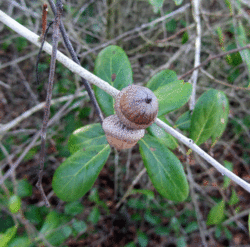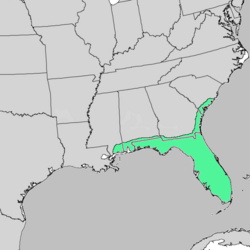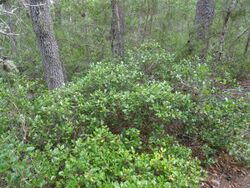Biology:Quercus myrtifolia
| Myrtle oak | |
|---|---|

| |
| Leaves and acorns of myrtle oak | |
| Scientific classification | |
| Kingdom: | Plantae |
| Clade: | Tracheophytes |
| Clade: | Angiosperms |
| Clade: | Eudicots |
| Clade: | Rosids |
| Order: | Fagales |
| Family: | Fagaceae |
| Genus: | Quercus |
| Subgenus: | Quercus subg. Quercus |
| Section: | Quercus sect. Lobatae |
| Species: | Q. myrtifolia
|
| Binomial name | |
| Quercus myrtifolia Willd.
| |

| |
| Synonyms[2] | |
|
List
| |
Quercus myrtifolia, the myrtle oak,[3] is a North American species of oak. It is native to the southeastern United States (Mississippi, Alabama, Florida, Georgia, South Carolina). It is often found in coastal areas on sandy soils.[4]
It is an evergreen tree that can reach 12 meters (39 feet) tall, also appearing as a shrub in drier sites. It has leaves with no teeth or lobes, which are hairless on the upperside and also on the underside except along the veins.[5]
Taxonomy
This plant was first identified by Carl Ludwig von Willdenow.[6] Some synonyms for Quercus myrtifolia are Quercus nitida, Quercus aquatica var. myrtifolia, Quercus myrtifolia f. ampla, Quercus phellos var. arenaria, and Quercus phellos var. myrtifolia.[7] The common name is the Myrtle Oak[8]
Description
The Myrtle Oak often grows as a shrub, but can also take the form of a tree. In maturity it grows to 15-20 feet tall and 8-10 feet wide. It is considered a red oak.[9] The leaves are simple alternate.[10] They appear dark green with a yellow-green underside. The leaves have a leathery texture, and an obovate shape.[10] There are small hairs on the underside of the leaves.[11] The acorns are about 1/2" long, and mature in 18 months.[12] Small green flowers bloom in April-May.[9] It has a grey smooth stem that furrows in maturity. Twigs can be reddish brown when they are younger.[10] A commonly associated oak of Q. myrtifolia is Quercus geminata. However, the leaf of Q. geminata is a narrow elliptic shape and has a wrinkled appearance. Quercus myrtifolia also grows better in shaded and upper dune environments.[13]
Distribution
Quercus myrtifolia is present in the souteastern United States.[8] It occurs in sandy soils along coastlines up to 350 ft above sea level.[9] Habitats are dry sandy ridges in scrub oak forests with yellow pines, and dry-site hardwood forests.[14] The most common trees it grows with are Quercus incana, Quercus laevis, Quercus marilandica, Quercus margaretta, Quercus geminata, and Quercus virginiana.[14]
Uses
This plant is mostly used in gardening as a backdrop or accent plant. It is very low maintenance and its evergreen leaves provide cover during the winter.[15] It may also have medicinal uses. The bark may be used as an antiseptic and hemostatic. It may even be useful for treating tooth aches, gastropathies, burns, and reduce inflammation.[16] These types of medicinal uses are typical of many oak trees.[17]
Climate resiliency
Increased levels of CO2 in the environment of Quercus myrtifolia led to a decrease in leaf area. Additionally, this also led to an increase in sugar and starch content.[18] Higher levels of CO2 led to lower occurrence of leaf asymmetry this can better protect leaves from leaf miners.[19] Prescribed burns may be beneficial to the recruitment of Q. myrtifolia seedlings.[20] It is also possible that mature Myrtle Oaks eventually stop producing acorns making fires important for the growth of new trees.[21] Prescribed burns may be beneficial to the recruitment of Q. myrtifolia seedlings.[20] Quercus myrtifolia displays resiliency to prescribed and lighting caused burns on the Florida Lake Wales Ridge.[22] After palmetto scrub fires Q. myrtifolia managed to reach preburn values within 5 years.[23] Seasonal drought can have a large impact on the Q. myrtifolia. A dry spring season is known to greatly decrease its growth rate.[24] Myrtle Oak is also considered to be extremely wind resistant.[25]
Pests
A variety of insects feed on the Myrtle Oak including oak skeletonizer, leaf miner, galls, oak lace bugs, borers, and caterpillars.[9] Burrowing beach mice threaten acorns even when protected by cages.[26] Hibiscus mealybugs are also known to host in the tree.[27] Like all oaks, Quercus myrtifolia is susceptible to oak wilt.[9] Seeds with holes in them may be infested with weevils.[28]
Cultivation
The Myrtle Oak can be used as an accent plant in garden settings. Despite this it is rarely available in nurseries. If growing a Myrtle Oak one should plant in full sun and well drained soil. It is very drought resistant.[29] If it is planted outside it should be protected from pests, and buried at a depth equal to the diameter of the acorn.[30]
Conservation
Myrtle Oak is considered critically imperiled in South Carolina, imperiled in Mississippi, and vulnerable in Georgia.[31]
References
- ↑ Wenzell , K.; Kenny, L. (2015). "Quercus myrtifolia". IUCN Red List of Threatened Species 2015: e.T194204A2303967. doi:10.2305/IUCN.UK.2015-4.RLTS.T194204A2303967.en. https://www.iucnredlist.org/species/194204/2303967. Retrieved 12 November 2021.
- ↑ "Quercus myrtifolia Willd. — The Plant List". theplantlist.org. http://www.theplantlist.org/tpl1.1/record/kew-174037.
- ↑ "Quercus myrtifolia". Natural Resources Conservation Service PLANTS Database. USDA. https://plants.usda.gov/core/profile?symbol=QUMY.
- ↑ "Biota of North America Program 2014 county distribution map". bonap.net. http://bonap.net/MapGallery/County/Quercus%20myrtifolia.png.
- ↑ "Flora of North America, Quercus myrtifolia Willdenow, 1805. Myrtle oak". efloras.org. http://www.efloras.org/florataxon.aspx?flora_id=1&taxon_id=233501066.
- ↑ "Quercus myrtifolia | International Plant Names Index". https://www.ipni.org/n/296482-1.
- ↑ "WFO Plant List | World Flora Online". https://wfoplantlist.org/plant-list/taxon/wfo-0000292105-2023-06?page=1.
- ↑ 8.0 8.1 "USDA Plants Database". https://plants.usda.gov/home/plantProfile?symbol=QUMY.
- ↑ 9.0 9.1 9.2 9.3 9.4 "Quercus myrtifolia - Plant Finder". https://www.missouribotanicalgarden.org/PlantFinder/PlantFinderDetails.aspx?taxonid=364592&isprofile=0&pt=2.
- ↑ 10.0 10.1 10.2 Proenza, Lynn; Andreu, Michael (2013-04-30). "Common Woody Plants of Florida Scrub Ecosystems". EDIS 2013 (4). doi:10.32473/edis-fr373-2012. ISSN 2576-0009.
- ↑ Milligan, Lara (2019-07-11). "The Little Oaks - Part I" (in en). https://blogs.ifas.ufl.edu/pinellasco/2019/07/11/the-little-oaks-part-i/.
- ↑ "SGEB-75-22/SG183: Myrtle Oak, Quercus myrtifolia" (in en). https://edis.ifas.ufl.edu/publication/SG183.
- ↑ Rogers, George K. (2023-01-01). "Comparative ecology of two closely associated scrub-dominating oaks in South Florida: Quercus myrtifolia and Q. geminata (Fagaceae)". Flora 298: 152201. doi:10.1016/j.flora.2022.152201. ISSN 0367-2530.
- ↑ 14.0 14.1 "Lady Bird Johnson Wildflower Center - The University of Texas at Austin". https://www.wildflower.org/plants/result.php?id_plant=QUMY#:~:text=Distribution&text=Native%20Distribution:%20South%20Carolina,%20south,scrub%20oak%20forests%20of%20Q..
- ↑ "Quercus myrtifolia (Myrtle Oak) | North Carolina Extension Gardener Plant Toolbox". https://plants.ces.ncsu.edu/plants/quercus-myrtifolia/.
- ↑ "Myrtle Oak". https://gulfspecimen.org/myrtle-oak/.
- ↑ Taib, Mehdi; Rezzak, Yassine; Bouyazza, Lahboub; Lyoussi, Badiaa (2020-07-31). "Medicinal Uses, Phytochemistry, and Pharmacological Activities of Quercus Species" (in en). Evidence-Based Complementary and Alternative Medicine 2020: 1–20. doi:10.1155/2020/1920683. ISSN 1741-427X. PMID 32802116.
- ↑ "Error: no
|title=specified when using {{Cite web}}". https://academic.oup.com/treephys/article/19/4-5/229/1689873. - ↑ Cornelissen, Tatiana; Stiling, Peter; Drake, Bert (January 2004). "Elevated CO 2 decreases leaf fluctuating asymmetry and herbivory by leaf miners on two oak species" (in en). Global Change Biology 10 (1): 27–36. doi:10.1111/j.1365-2486.2003.00712.x. ISSN 1354-1013. Bibcode: 2004GCBio..10...27C. https://onlinelibrary.wiley.com/doi/10.1111/j.1365-2486.2003.00712.x.
- ↑ 20.0 20.1 Ruth, Andrew D.; Miller, Deborah L.; Jose, Shibu; Long, Alan (October 2007). [332:eorofi2.0.co;2 "Effects of Reintroduction of Fire into Fire Suppressed Coastal Scrub and Longleaf Pine Communities Along the Lower Gulf Coastal Plain"]. Natural Areas Journal 27 (4): 332–344. doi:10.3375/0885-8608(2007)27[332:eorofi2.0.co;2]. ISSN 0885-8608. http://dx.doi.org/10.3375/0885-8608(2007)27[332:eorofi]2.0.co;2.
- ↑ Abrahamson, Warren G.; Layne, James N. (February 2002). "Relation of ramet size to acorn production in five oak species of xeric upland habitats in south-central Florida". American Journal of Botany 89 (1): 124–131. doi:10.3732/ajb.89.1.124. ISSN 0002-9122. PMID 21669720. http://dx.doi.org/10.3732/ajb.89.1.124.
- ↑ Abrahamson, Warren G. (January 1984). "Species Responses to Fire on the Florida Lake Wales Ridge" (in en). American Journal of Botany 71 (1): 35–43. doi:10.1002/j.1537-2197.1984.tb12482.x. ISSN 0002-9122. https://bsapubs.onlinelibrary.wiley.com/doi/10.1002/j.1537-2197.1984.tb12482.x.
- ↑ Schmalzer, Paul A.; Foster, Tammy E. (2022-07-30). "Effects of repeated fire on Florida oak-saw palmetto scrub". Fire Ecology 18 (1): 16. doi:10.1186/s42408-022-00140-9. ISSN 1933-9747. Bibcode: 2022FiEco..18a..16S.
- ↑ Foster, Tammy E. (July 2014). "Timing matters: the seasonal effect of drought on tree growth1". The Journal of the Torrey Botanical Society 141 (3): 225–241. doi:10.3159/TORREY-D-13-00060.1. ISSN 1095-5674. https://bioone.org/journals/the-journal-of-the-torrey-botanical-society/volume-141/issue-3/TORREY-D-13-00060.1/Timing-matters--the-seasonal-effect-of-drought-on-tree/10.3159/TORREY-D-13-00060.1.full.
- ↑ Duryea, Mary L.; Kampf, Eliana (2007-11-19). "Selecting Southeastern Coastal Plain Tree Species for Wind Resistance". EDIS 2007 (20). doi:10.32473/edis-fr174-2007. ISSN 2576-0009.
- ↑ Tobing, Sarah Lumban; Thetford, Mack; Miller, Deborah L. (July 2018). "Germination and Predation of Quercus geminata and Quercus myrtifolia Acorns on Santa Rosa Island, Florida". Journal of Coastal Research 34 (4): 900–910. doi:10.2112/JCOASTRES-D-17-00048.1. ISSN 0749-0208. https://bioone.org/journals/journal-of-coastal-research/volume-34/issue-4/JCOASTRES-D-17-00048.1/Germination-and-Predation-of-Quercus-geminata-and-Quercus-myrtifolia-Acorns/10.2112/JCOASTRES-D-17-00048.1.full.
- ↑ "Error: no
|title=specified when using {{Cite web}}". https://academic.oup.com/jipm/article/14/1/3/7024607. - ↑ "SGEB-75-22/SG183: Myrtle Oak, Quercus myrtifolia" (in en). https://edis.ifas.ufl.edu/publication/SG183.
- ↑ "Quercus myrtifolia" (in en). https://www.unf.edu/botanical-garden/plants/quercus-myrtifolia.html.
- ↑ Miller, Debbie L.; Thetford, Mack; Verlinde, Chris M.; Campbell, Gabriel; Smith, Ashlynn (2018-09-28). "Dune Restoration and Enhancement for the Florida Panhandle". EDIS 2018 (5). doi:10.32473/edis-sg156-2018. ISSN 2576-0009. https://journals.flvc.org/edis/article/view/105380.
- ↑ "NatureServe Explorer 2.0". https://explorer.natureserve.org/Taxon/ELEMENT_GLOBAL.2.151806/Quercus_myrtifolia.
External links
Wikidata ☰ Q6371836 entry
 |



